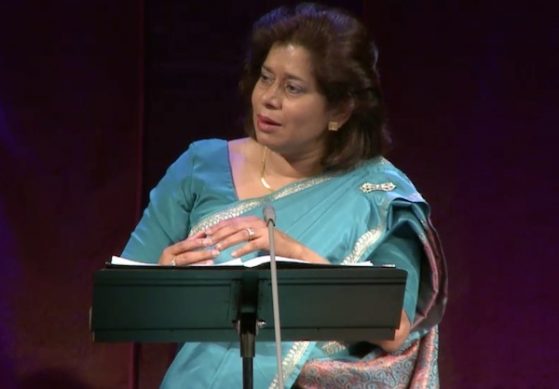Darbar Chhayanat
LINK TO: Link
YEAR: 2010
ORCHESTRATION: Tanpura, Tabla, Viola, Violoncello
DURATION: 34'
LANGUAGE: Braj Bhasha
SOLOIST(S): Soprano, Classical Indian vocalist (Khayal)
COMMISSIONED BY: Darbar Arts Culture Heritage
PREMIERE DATE: April 1, 2010
PREMIERE INFORMATION:
When the South Asian Arts group Darbar approached me to devise a musical Encounter between fine Indian and Western musicians, I was intrigued. This was an idea whose time had come. Darbar wanted a work where musicians from both cultures could meet on common ground and yet articulate their mastery and musicianship within their individual stylistic spheres. It was thus an idea in counterpoint, the intermingling of two musics, blending together two streams of musical consciousness both texturally and harmonically, whilst retaining their uniqueness.
For a western musician however (albeit one with an Indian background, such as myself), dealing with the extraordinary fluidity of the Raag can be a daunting prospect. The Indian Raag has an intoxicatingly powerful allure; the word itself means ‘that which dyes the mind in colour’. It is exceedingly difficult for Western musicians not to be drawn into its vortex, to the point where their role becomes subjugated to the nuances of a Raag’s very powerful identity. I did not however want the western musicians in this project to merely respond through the imitation of surface gestures of Indian music. The problem is especially compounded when dealing with the human voice.
I have therefore tried to create a music that partakes of both traditions, placing Patricia Rozario’s voice in a medium to high register in a way that could complement Veena Sahasrabuddhe’s mellifluent delivery in the lower register. There is an unabashed coexistence of Indian Taans (extremely rapid melodic passages sung on the syllable “a”) and Western Coloratura (florid high vocal passages), especially in the fast passages toward the end of the work. I hope this approach might allow the rich melismatic raag-based vocal line to retain its freedom and vivacity, whilst engaging in a counterpoint with a Western voice. The instrumental writing, for its part, draws on the resources of the string instruments: sarangi, viola and cello. These exhibit different approaches to instrumentation, bow technique, counterpoint and the use of scalic material; but in the intermingling of these instrumental styles, I hope a rich tapestry emerges.
With regard to pitch and rhythmic material, my natural instinct as a contemporary composer was to use the gamut of twentieth century harmonic and textural techniques, and give the Raag a modern edge. However, the three traditional Bandishes (compositions) that form the core of the vocal performance are remarkably beautiful in their pitch profile, within the ambit of Raag Chhayanat and it would have been pointless to disturb their delicate scalic balance in the quest for modernity. So I have chosen a Raag-based contrapuntal style that allows western musicians the opportunity to articulate something complementary and not distracting, whilst the Indian music retains all of its ornament-rich delicacy, fluidity and vitality.
Rhythmically the work divides into sections of unmeasured tempo (as in the very beginning), and then three sections of measured tempo set in Jhumra Taal (14 beats per cycle) and Teen Taal (16 beats per cycle). The overall trajectory moves from slow to fast. Not all of the music for the western musicians is fully notated: in some areas they must improvise according to strict rules. Nor is the junction between east and west is always clear: sometimes the two musics might be abruptly juxtaposed, other times layered and concealed.
The sung texts are in Braj Bhasha (a central Indian language closely related to Hindi), with an English version by William Radice. The overall mood is of the ‘rasa’ of pure sringara (eros, tender love) and I hope this is a metaphor too for the intertwining of the two exquisite traditions of music making in a joyful union. The work is entitled Darbar Chhayanat in tribute to the group Darbar that had the vision to commission it.
© Param Vir
March 2010
DARBAR CHHAYANAT
Original Text (traditional)
English version by William Radice
I. Vilambit laya, Jhumra Taal
Slow Tempo (adagio)
eri aba goonde laavo ri maalaniyaa
oh stitch a garland and bring it to me
naushe bane ke seesa sehraa
the groom is dressed so handsomely
laagee lagana shyaama salone kee
the bride adores his dark allure
banaree ke sanga nehaa
his love for her is just as sure
eri aba goonde laavo ri maalaniyaa
oh stitch a garland and bring it to me
naushe bane ke seesa sehraa
the groom is dressed so handsomely
II. Madhya laya, Teen Taal
Medium Tempo (moderato)
sandesavaa piyaa se moraa kahiyo jaaya
if you can give him a message from me
re bhanvaraa, gaaoongee guNa mein toraa
I’ll sing your praises, bumblebee
jabase gaye piyaa desa videsavaa
the moment my love went far away
kaTata naahin dina-raina jharata jala nainavaa
I wept and pined all night and day
III. Drut laya, Teen Taal
Fast Tempo (allegro/presto)
eri malaniyaa goonde laavo ri
oh stitch a garland and bring it to me
phoolanake haravaa piyaa gare daaroongee
I long to adorn him gorgeously
chuna-chuna kaliyaan, donaa-maravaa
I’ll pick the buds and herbs whose scent
phoolanake haravaa daaroon garavaa
will make him swoon in ravishment
piyaasanga hila-mila navelariyaa
forever with me as his bride content
The Hindu (2 May 2010)
Reviewer: Vayu Naidu
Darbar launched its fifth festival with Encounter — a composition for female vocalists of Indian and Western classical traditions by British contemporary music composer Param Vir, with Veena Sahasrabudhe and Patricia Rozario. The confidence in taking audiences across time lines of two distinctive traditions, and then having them create a tapestry of interwoven notes struck a chord with how global imagination works — each of us secure in our homes migrating through cyberspace into the grids of homes and hearts of other continents.


